目录
上一篇我么讲解了运算符重载的知识,今天我们通过一个例子Data日期类来巩固运算符重载的知识。
本篇文章我们将实现下面下面这些函数接口:
class Date { public: // 获取某年某月的天数 int GetMonthDay(int year, int month); // 全缺省的构造函数 Date(int year = 1900, int month = 1, int day = 1); // 拷贝构造函数 //d2(d1) Date(const Date& d); // 赋值运算符重载 // d2 = d3 -> d2.operator=(&d2, d3) Date& operator=(const Date& d); // 析构函数 ~Date(); // 日期+=天数 Date& operator+=(int day); // 日期+天数 Date operator+(int day); // 日期-天数 Date operator-(int day); // 日期-=天数 Date& operator-=(int day); // 前置++ Date& operator++(); // 后置++ Date operator++(int); // 后置-- Date operator--(int); // 前置-- Date& operator--(); // >运算符重载 bool operator>(const Date& d); // ==运算符重载 bool operator==(const Date& d); // >=运算符重载 inline bool operator >= (const Date& d); // <运算符重载 bool operator < (const Date& d); // <=运算符重载 bool operator <= (const Date& d); // !=运算符重载 bool operator != (const Date& d); // 日期-日期 返回天数 int operator-(const Date& d); private: int _year; int _month; int _day; };我们可以采用多文件的形式储存:
1. 全缺省的构造函数
构造函数其实就是初始化的一个过程,尤其注意的是对于日期的一个合法性的判断。但是因为月份的天数的细微差距,这里调用一个GetMonthDay()函数接口来完成:
int Date::GetMonthDay(int year, int month) { assert(year >= 0 && month < 13 && month>0); //开辟一个静态区间,用来解决不同月份的天数不同 static int monthDayAraay[13] = { 0,31,28,31,30,31,30,31,31,30,31,30,31 }; if (month == 2 && isLeapYear(month)) { return 29; } return monthDayAraay[month]; }这里因为月份对应的天数是固定的,所以我们选择将每个月的天数储存在一个静态数组中,这样一来就可以做到一次的开辟,之后可以进行多次的调用。
同时因为二月天数收年份影响,所以这里继续编写一个判断是都为闰年的函数接口isLeapYear(),如果十二月份并且是闰年则直接返回29:
bool isLeapYear(int year) { return (year % 100 != 0 && year % 4 == 0) || (year % 400 == 0); }上面就是我们应该在构造函数中进行的日期是否合法的判断,所以我们最终的构造函数应该是:
Date::Date(int year, int month, int day) { if (year > 0 && month < 13 && month>0 && day > 0 && day <= GetMonthDay(year,month)) { _year = year; _month = month; _day = day; } else { cout << "日期不合翻!" << endl; exit(-1); } }
2. opeartor ==
判断两个日期是否相等很简单,只需要将年月日的比较结果进行与逻辑判断即可:
bool Date::operator == (const Date & d) { return _year == d._year && _month == d._month && _day == d._day; }
3. operator <
要想判断日期<日期:
- 先比较year,如果year小的话,后面就无须比较了,直接返回ture
- 如果year相等,就比较month,如果month小的话,后面也无须比较,直接返回ture
- 如果year、month都相等时,最后才比较day,如果day小,直接返回ture
bool Date::operator < (const Date& d) { if (_year < d._year || (_year == d._year && _month < d._month) || (_year == d._year && _month == d._month && _day < d._day) ) { return true; } else { return false; } }
4. operator <=
因为我们已经写了 < 和 <=的接口了,而 <= 逻辑包含了前两者,所以只需要任意满足一个即可返回true:
bool operator <= (const Date& d) { return *this < d || *this == d; }
5. operator !=
显然 == 和 != 形成逻辑非关系,所有只需要对 == 取反即可:
bool operator != (const Date& d) { return !(*this == d); }
6.operator >
> 和 <= 构成逻辑非,因此只需要对<=取反即可。
bool operator>(const Date& d) { return !(*this <= d); }
7.operator >=
>= 和 < 构成逻辑非,因此只需要对 < 取反即可:
bool operator>=(const Date& d) { return !(*this < d); }
由上面的实现我们可以知道只要有了 == 和 < 接口我们就可以通过直接调用这两个接口实现其他的接口。因为接口的代码量比较小,所以我们选择将其直接写在类中,因为在类中实现的函数,编译器会将其默认为内联函数(内联函数可以减少函数调用的开销)。
8. operator +=
+= 的逻辑是给出一个日期和一个天数,然后计算这个日期加上天数后的新日期,也就是说要返回一个Date日期类:
Date& Date::operator += (int day) { //如果day是负数,那么就转换成为正数的-=运算 if (day < 0) { return *this -= -day; } _day += day; while (_day>GetMonthDay(_year,_month)) { _day -= GetMonthDay(_year, _month); _month++; if (_month > 12) { _year++; _month = 1; } } return *this; }运行结果如下:
显然结果正确!!!
9. operator +
我们前面已经实现了 += ,两者的区别在于 += 会改变日期本身,但是 + 只是修改了一个拷贝(并不会影响原来的数据):
Date Date::operator + (int day) { Date ret(*this); ret += day; return ret; }测试结果:
10. operator -=
-= 的逻辑和 += 差不多,但是要注意一点细节:
Date& Date::operator -= (int day) { if (day < 0) { return *this += -day; } _day -= day; while (_day <= 0) //注意这个边界条件 { _month--; if (_month == 0) { _month = 12; _year--; } _day += GetMonthDay(_year, _month); } return *this; }
11. operator -
同理:
Date Date::operator - (int day) { Date ret(*this); ret -= day; return ret; }测试结果:
12. 前置++、前置--、后置++、后置--
我们发现前置++和后置++的操作符都是++操作符,并且他们的返回类型,函数名,参数列表都一模一样。那么他们我们应该怎么区别呢?
这个问题其实编译器也考虑到了,因此编译器为了区别前置++和后置++,编译器规定,后置++(或后置--)的参数列表中多穿一个值。此时因为两个函数的参数列表的参数个数不同,两个函数就构成了函数重载。就可以区分两个操作符了。
需要注意的是,加的这个参数是为了区分前置和后置,因此传过来的值无所谓。我们一般可以省略写就直接只写数据类型。
因此,前置++就相当于是 +=1:
Date& operator++() { *this += 1; return *this; }前置--就相当于 -=1:
Date& operator--() { *this -= 1; return *this; }后置++先使用,因此要创建一个tmp存上,再自身++:
Date operator++(int) { Date tmp(*this); *this += 1; return tmp; }后置--先使用,因此要创建一个tmp存上,再自身--:
Date operator--(int)//加参数为了区分,与传过来的值无关 { Date tmp(*this); *this -= 1; return tmp; }测试结果:
注意哦!重载之后的后置--,同样是先赋值再--。
13.日期-日期
这个接口我们要实现一个日期与另一个日期之间相差多少天。如果是小日期-大日期,应该返回一个负数。因此我们要对这个小细节进行处理。
这里的实现逻辑是:
- 我们先默认第一个日期为大日期,第二个日期为小日期
- 我们在对这两个进行比较,如果第一个是小日期,我们就将max和min进行日期调换。如果调换说明是小日期-大日期,最终的结果理应该是个负数。因此我们定义一个flag = 1,如果这里调换的话,让flag = -,最终返回n*flag即可
- 我们要始终保持小追大。我们使用前置++运算,让小的日期追大的日期,这里需要定义一个计数器n。每++一次,n就++一次
int Date::operator-(const Date& d) { int flag = 1; Date max = *this;//默认认为第一大 Date min = d; if (*this < d) { min = *this; max = d; flag = -1; } int n = 0; while (min != max) { ++n; ++min; } return n*flag; }测试结果:
(本篇完)
完整代码在下面哦
 C++日期类运算符重载实例解析
C++日期类运算符重载实例解析






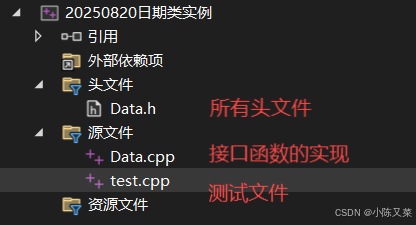



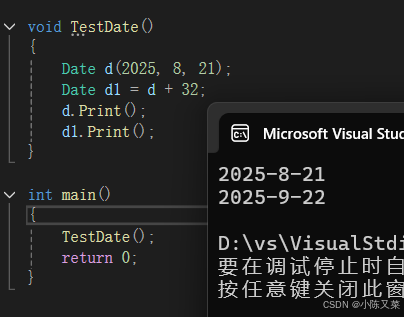

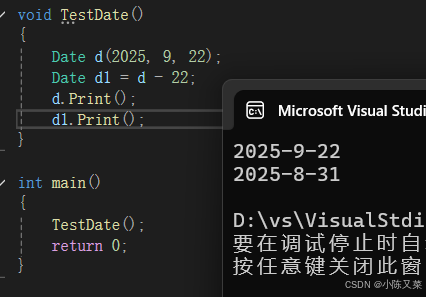
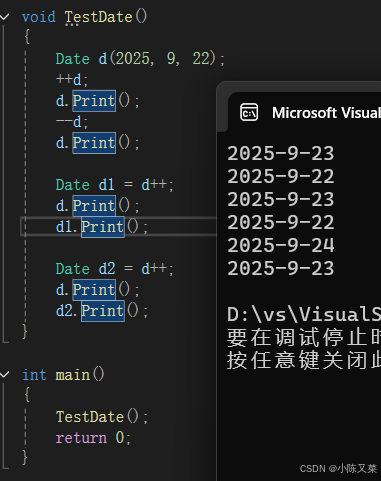
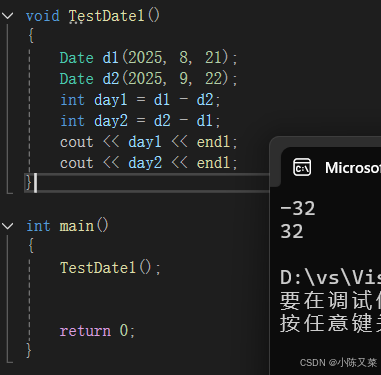

















 被折叠的 条评论
为什么被折叠?
被折叠的 条评论
为什么被折叠?








